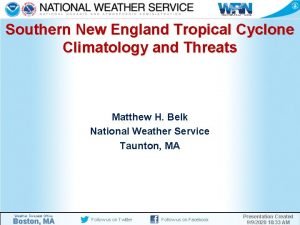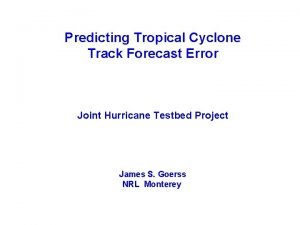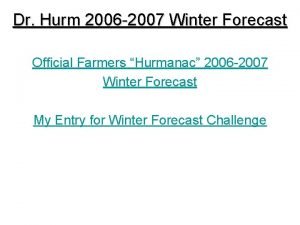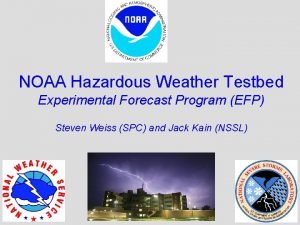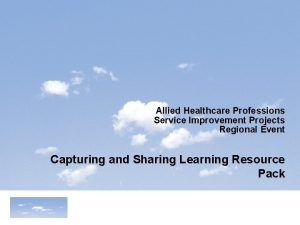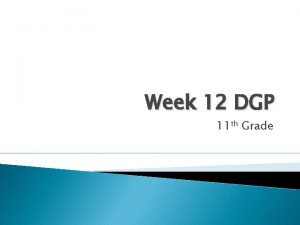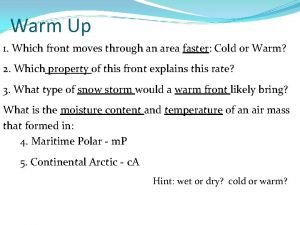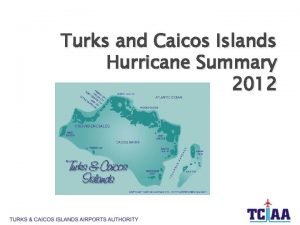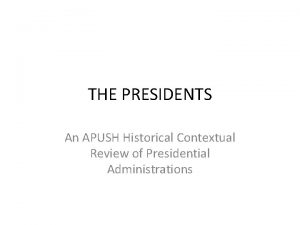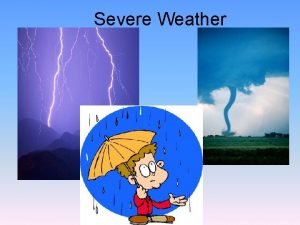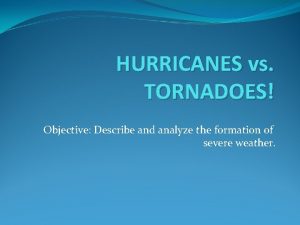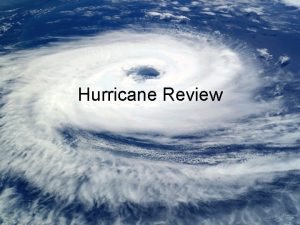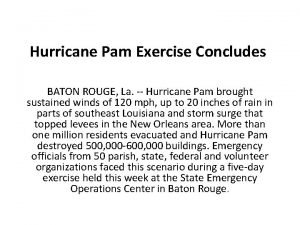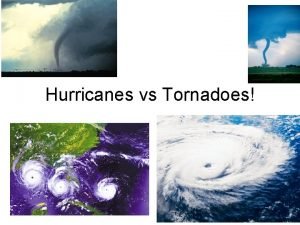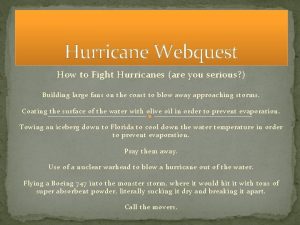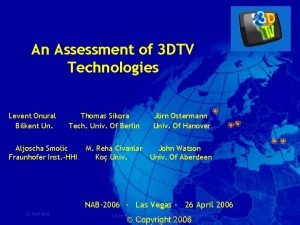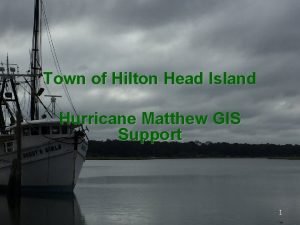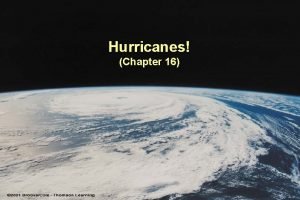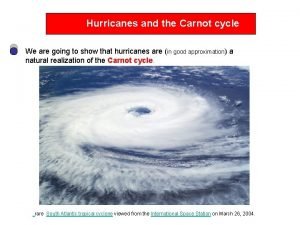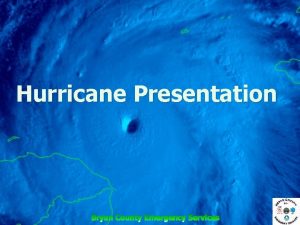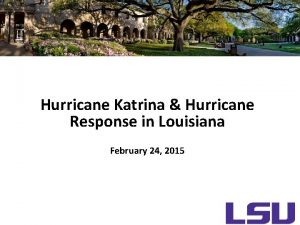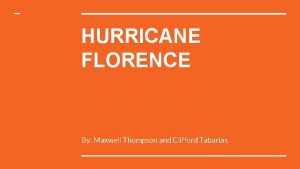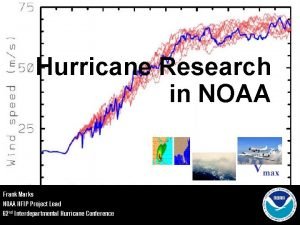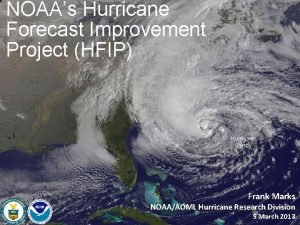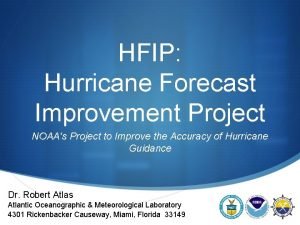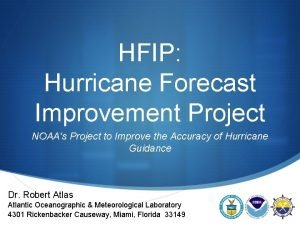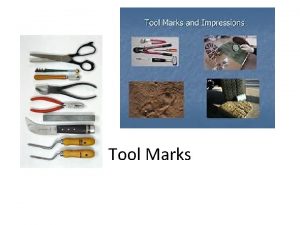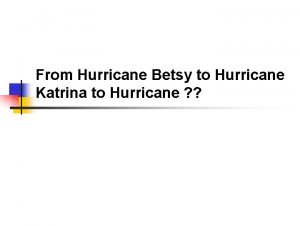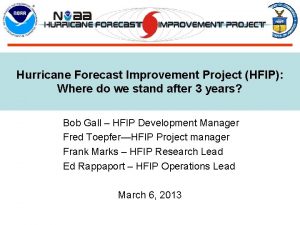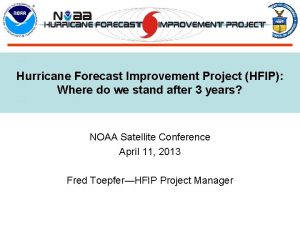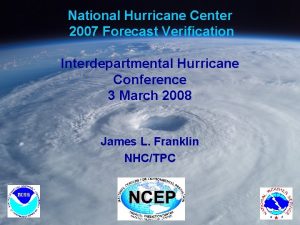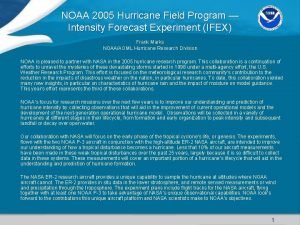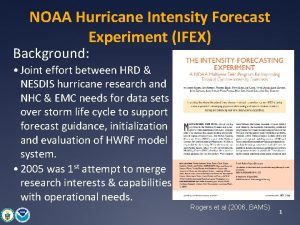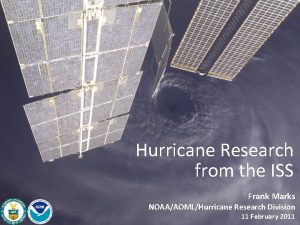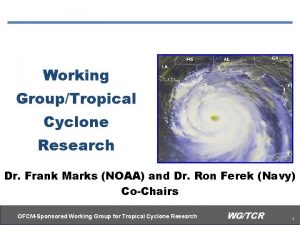NOAA Hurricane Forecast Improvement Project Frank Marks NOAA





























- Slides: 29

NOAA Hurricane Forecast Improvement Project Frank Marks NOAA HFIP Lead Director, NOAA/AOML Hurricane Research Division 4 November 2009

Hurricane Research Timeline 1997 1998 1999 USWRP PDT-5 OFCM National Plan for Tropical Cyclone Research and Reconnaissance NOAA HFP USWRP Hurricanes at Landfall Workshop IWTCIV 2000 2001 2002 2003 2004 2005 2006 2007 2008 2009 USWRP Hurricanes at Landfall Implementation Plan IWTCV NASA NOAA CAMEX-3, HFP NOAA HFP NASA CAMEX-4, NOAA HFP National Hurricane Forecast Improvement Project Meeting the Nation’s Needs 2

USWRP HL GOALS - 1997 • • Reduce overwarned area at 24 h by half. Requires cutting track error by 30%, improving 34 -kt wind radii forecast accuracy 20%, and provide better estimate of uncertainty. Reduce intensity forecast error to within 1/2 category at 24 h and 1 category at 48 h. Develop methods forecasting TC wind and precipitation structure at and after landfall. Develop better understanding of costs and benefits of reducing errors in all of the above forecast measures to drive policy tradeoffs National Hurricane Forecast Improvement Project Meeting the Nation’s Needs 3

Hurricane Research Timeline 1997 1998 1999 USWRP PDT-5 OFCM National Plan for Tropical Cyclone Research and Reconnaissance NOAA HFP USWRP Hurricanes at Landfall Workshop IWTCIV 2000 2001 2002 USWRP Hurricanes at Landfall Implementation Plan IWTCV Joint Hurricane Testbed NOAA & USWRP NASA NOAA CAMEX-3, HFP NOAA HFP NASA CAMEX-4, NOAA HFP 2003 2004 2005 2006 2007 2008 2009 5 TCs hit US Katrina & Rita NOAA Science & Technology Infusion Program Plan NOAA HFP IWTCNOAA VI Hurricane Research Initiative NOAA HFP NASA TCSP, NSF RAINEX, NOAA IFEX NOAA SAB HIRWG, NSB NHRI, OFCM National Plan for Tropical Cyclone Research NASA AMMA, NOAA IFEX National Hurricane Forecast Improvement Project Meeting the Nation’s Needs NOAA HFIP NOAA IFEX 4

Developing a National Hurricane Research Agenda Fall 2005 – OFCM forms Joint Action Group for TC Research (JAG/TCR), NOAA Science Advisory Board (SAB) forms Hurricane Intensity Working Group (HIRWG), NSB investigates national hurricane research needs Winter 2007 – JAG/TCR, HIRWG, & NSB reports released Summer 2007 – NOAA forms Hurricane Forecast Improvement Project (HFIP) in response to HIRWG recommendations. National Hurricane Forecast Improvement Project Meeting the Nation’s Needs 5

Goals • Improve Forecast Accuracy • Hurricane impact areas (track) – 50% in 10 years • Severity (intensity) – 50% in 10 years • Storm surge impact locations and severity • Extend forecast reliability out to 7 days • Quantify, bound and reduce forecast uncertainty to enable risk management decisions National Hurricane Forecast Improvement Project Meeting the Nation’s Needs 6

How to get there? Ø Science • Improved understanding from combination of observations and models • Higher resolution coupled models – critical to storm evolution forecasts – especially intensity changes • Forecast techniques to understand, reduce and communicate uncertainty Ø Information Technology • Increased computing power - run advanced hurricane/global models and reduce uncertainty • IT infrastructure for inter-agency data exchange Ø Observing Strategy • Improved use of existing and planned systems Ø Improved Products for Forecasters National Hurricane Forecast Improvement Project Meeting the Nation’s Needs 7

Improved Models: Statistical -dynamical models • SHIPS, LGEM, & RI-index are skillful sources of intensity guidance • SHIPS & LGEM contain ~55 -60% of the variance in intensity change, RIIndex ~30% of RI variance, primarily from large-scale in GFS. • Until regional models improve there is value in improving statisticaldynamical approaches. Milestones: • Improve statistical model accuracy (LGEM, SHIPS, RI index) • Identify model deficiencies (LGEM, SHIPS, RI index) • Use statistical models to evaluate regional models • Transition applications into operations - JHT National Hurricane Forecast Improvement Project Meeting the Nation’s Needs 8

Improved Models: Statistical -dynamical models-RI • RI much more prevalent in weaker systems (~70% of occurrence in storms <Cat 1) ATL EPAC • RI Index has much higher POD than any dynamical model and OFCL in both ATL and EPAC • FAR for RI index comparable to dynamical models and OFCL Kaplan et al (2009) National Hurricane Forecast Improvement Project Meeting the Nation’s Needs 9

Improved Models: Dynamical Models National Hurricane Forecast System Global: • FIM global model developed at ESRL with help from NCEP • Uses unique global grid (soccer-balllike horizontal, adaptive vertical coordinate) Regional: • Experimental HWRF developed at AOML & ESRL based on NCEP HWRF • Triply-nested regional model down to 1 -km horizontal resolution D 1 D 2 National Hurricane Forecast Improvement Project Meeting the Nation’s Needs 10

Global Model Development - FIM Model tracks – init 00 Z 19 August FIM Courtesy of Stan Benjamin National Hurricane Forecast Improvement Project Meeting the Nation’s Needs 11

Regional Model Development - HWRFx 2009 hurricane season: HWRFx real-time demo simulations (https: //storm. aoml. noaa. gov/hwrfx/) • Ran HWRFx at resolution (9/3 km), no ocean, no vortex initialization (HWRF IC/BC) • HWRFx run real-time twice a day (00 Z, 12 Z) for >100 cases 126 h forecasts • Provided in ATCF format to DTC & multi-model regional ensemble • NJET statistics (average): • Simulation time: 2. 5 h • Post-processing: 50 min National Hurricane Forecast Improvement Project Meeting the Nation’s Needs 12

Single Model Ensembles: Bill Courtesy of Fuqing Zhang (PSU) tracks Max 10 -m wind swath & ensemble track National Hurricane Forecast Improvement Project Meeting the Nation’s Needs 13

Single Model Ensembles: Erika ICs: GFS-En. KF analysis BCs: GFS forecast Courtesy Fuqing Zhang (PSU) National Hurricane Forecast Improvement Project Meeting the Nation’s Needs 14

Multi-model Ensembles 2009 hurricane season: Hurricane Bill • Multi-model regional ensemble • HWRFx does better on intensity for strong hurricanes (Bill & Fred), but worse for weak systems (Ana, Danny, Erika, AL 08, & Henri) • HWRFx sensitivity tests with GFS IC vs HWRF IC has inverse behavior when using GFS IC (e. g. , weak bias with strong storms), & track error worse Hurricane Bill TS Henri National Hurricane Forecast Improvement Project Meeting the Nation’s Needs 15

Improved Observations In-situ • Wind, press. , temp. Expendables • • Dropsondes AXBT, AXCP, buoy Remote Sensors • • Doppler radar analysis overlaid by Aerosonde and coincident WP-3 D track in TS Ophelia 16 Sept 2005 Doppler Radar SFMR Scatterometer/ profiler UAS National Hurricane Forecast Improvement Project Meeting the Nation’s Needs 16

Improved Models & Data: Data Assimilation En. KF data assimilation of inner core observations 20° Vr SOs 03 -07 Z 19 August D 3 1 st real-time SOs transmitted during P -3 mission and assimilated few hours later D 2 D 3 TS Fay (2008) D 1 Courtesy of Fuqing Zhang (PSU) National Hurricane Forecast Improvement Project Meeting the Nation’s Needs 17

WRF-En. KF with P 3 radar Real-time Flow +04: 25 Get GFS Data 16 cores 32 cores 64 x 30 cores +04: 27 WPS +04: 40 +05: 00 Ensemble 24 hr Ensemble Generation forecast +11: 30 +05: 45 Waiting for SO En. KF +? ? : ? ? 132 hr lead time DF&EF 384 cores 384 x 31 cores 00 and 12 UTC 2 times/day Courtesy Fuqing Zhang (PSU) 64 x 30 cores +0912 hr Depending on SO http: //hfip. psu. edu/html/En. KFroutine. html National Hurricane Forecast Improvement Project Meeting the Nation’s Needs 18

Improved Models & Data: On-demand Test Demonstrate potential of on-demand computing & inform future needs Operating System: Number of Cores: Total Memory: Disk: National Hurricane Forecast Improvement Project Meeting the Nation’s Needs Linux 62, 976 123 TB 1. 73 PB 19

Improved Models & Data: On-demand Test: Bill P-3 Flight Tracks ARW-TACC 20090819 00 UTC Doppler SO (En. KF) transmitted in real-time to TACC for assimilation into ARW model 20090818 I 1 2126 -0229 UTC 5 missions at 12 -h intervals 00 Z 19 – 00 Z 21 August collecting Doppler SO (En. KF) ARW-TACC 20090819 00 UTC National Hurricane Forecast Improvement Project Meeting the Nation’s Needs 20

Improved Models & Data: Assimilation of Doppler data 10 m wind speed Contour: prior Shaded: posterior Courtesy Fuqing Zhang (PSU) 10 m wind speed Increments: Posterior - prior National Hurricane Forecast Improvement Project Meeting the Nation’s Needs 21

Improved Models & Data: On-demand Test: Bill Observed 00 Z 20 August 20090819 I 2 2137 -0224 UTC COAMPS 24 h HWRFx initialized 00 Z 19 August National Hurricane Forecast Improvement Project 24 h forecast initialized at 00 Z 19 August Meeting the Nation’s Needs 22

Improved Models & Data: Boundary Layer Physics–Bill HWRFx 63 h Hurricane Bill 00 Z 16 August Hurricane Bill (2009): • HWRFx wind & thermodynamic structure compared to observations (dropsondes & HWind) • U 10 OK, T 10 high 23 HWind 1730 UTC 18 Sept National Hurricane Forecast Improvement Project Meeting the Nation’s Needs 23

Improved Models & Data: Visualization • Integration of HWind database & Model • Integration of HWind database & NRL satellite imagery Hurricane Ike (2008) TS Fay (2008) • Exploring AWIPS-II integration through use of common standards Hurricane Danny (2009) • Integration of HWind database & You. Tube National Hurricane Forecast Improvement Project Meeting the Nation’s Needs 24

OFCM WG/TCR Objectives • Monitor and update operational needs of tropical cyclone forecast and warning centers (Table 1) • Review and update research priorities (Table 2) • Summarize agency research efforts against research priorities • Develop interagency implementation strategy – Leverage agency existing plans / resources to ensure all priorities addressed • Review implementation strategy at annual IHC National Hurricane Forecast Improvement Project Meeting the Nation’s Needs 25

OFCM WG/TCR Summary of Federal TC Research Total Man-Years: 228 2008 Total $ With Facilities: $50. 2 M Without Facilities: 37. 7 M National Hurricane Forecast Improvement Project Meeting the Nation’s Needs 26

Combined Man-Years Mapped to JTWC Priorities Intensity & Structure: ~ 35% TC Research Roughly Aligned with Operational Priorities W In Ge St QP Ob SS St Tr Siz Ra M Fc Se in at or ac TG d e/ ne F se o Ch ten s d ar as En de m k. F t. E Ai St rv sis A r an sit / on ad ds Su na se l R ru ffi Sa cs at ge y al m es ie t cie rg ct io l t y. n b ur Pr sis ns e Da nc ts le vs e og s ta y s National Hurricane Forecast Improvement Project Meeting the Nation’s Needs 27

OFCM WG/TCR Summary / Next Steps First-ever linkage of TC research to tropical forecast and warning center’s operational priorities • Developed repeatable process that can be updated on an annual basis • Allows direct application of research investments to desired operational capabilities Next steps • Agree on interagency strategic objectives (track, intensity, genesis) • Relate research efforts toward achieving strategic objectives • Document work of WG/TCR • Formalize executive oversight National Hurricane Forecast Improvement Project Meeting the Nation’s Needs 28

Questions?
 Hurricane tropical storm forecast
Hurricane tropical storm forecast Hurricane tropical storm forecast
Hurricane tropical storm forecast Raleighwx
Raleighwx Noaa experimental forecast
Noaa experimental forecast Where to use exclamation mark
Where to use exclamation mark Frank william abagnale jr. frank abagnale, sr.
Frank william abagnale jr. frank abagnale, sr. The allied health profession service improvement project
The allied health profession service improvement project The allied health profession service improvement project
The allied health profession service improvement project Frank gehry seattle
Frank gehry seattle Cannibal canoe hurricane and barbecue
Cannibal canoe hurricane and barbecue Raging planet hurricane worksheet answer key
Raging planet hurricane worksheet answer key Turks and caicos hurricane season
Turks and caicos hurricane season Hurricane katrina apush
Hurricane katrina apush Contrast signal words
Contrast signal words Hurricane diagram labeled
Hurricane diagram labeled Hurricane and tornado venn diagram
Hurricane and tornado venn diagram Cross section of a tropical storm
Cross section of a tropical storm At the periphery of a hurricane the air is ____
At the periphery of a hurricane the air is ____ What was hurricane pam
What was hurricane pam Similarities of tornadoes and hurricanes
Similarities of tornadoes and hurricanes Barbados hurricane risk
Barbados hurricane risk Hurricane webquest
Hurricane webquest 2006 hurricane season
2006 hurricane season Hilton head gis
Hilton head gis Florida hurricane catastrophe fund
Florida hurricane catastrophe fund Annotated cross section of a tropical cyclone
Annotated cross section of a tropical cyclone Hurricane carnot engine
Hurricane carnot engine What is a hurricane
What is a hurricane Contraflow new orleans
Contraflow new orleans Hurricane florence statistics
Hurricane florence statistics
